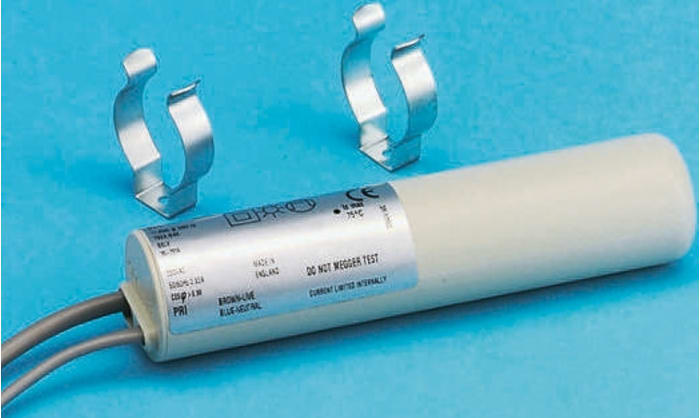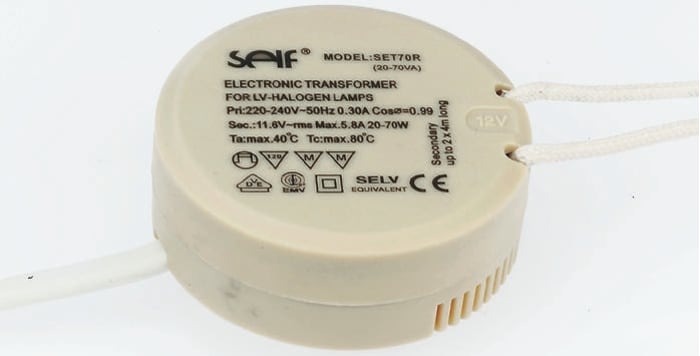Transformador de iluminación RS PRO, 230V ac, 11.5V, 20 → 70W, Electrónico

Documentos Técnicos
Especificaciones
Brand
RS ProTensión nominal primaria
230V ac
Tensión nominal secundaria
11.5V
Potencia Nominal
20 → 70W
Dimensiones
53 (diám.) x 22 mm
Profundidad
22 mm
Requisito de carga mínimo
20W
Temperatura Máxima
+45°C
Peso
70 g
Tipo
Electronic
Atenuación
Dimming
Método de atenuación
Salida
Diámetro
53mm
Frecuencia de funcionamiento mínima
50Hz
Tipo de Terminación
Cable de conexión
Características de protección
Protección contra sobrecorriente, protección contra exceso de temperatura, protección contra sobrecarga, protección contra cortocircuito
Frecuencia de funcionamiento máxima
60Hz
País de Origen
Italy
Datos del producto
Transformador Electrónico En Miniatura Atenuable Redondo De Salida Única
Transformador independiente IP20 para lámparas halógenas de 12 V.
Protección de clase II contra descargas eléctricas tras contacto directo e indirecto
El transformador se suministra con cables en los circuitos primario y secundario
Excelente fiabilidad de funcionamiento a temperaturas muy altas (ta = 45 °C; TC = 90 °C)
Tamaño compacto y pequeño
Montaje e instalación sencillos
Protegido contra sobrecalentamiento, cortocircuitos, picos de tensión y sobrecargas
Low Voltage Lighting Transformers
Dimming Methods (where applicable):
Leading Edge:
The control device is either a thyristor or triac which blocks power until they are switched on by the control signal. At that point the current flows almost instantaneously and continues to flow until the end of the half cycle of the mains waveform. When the signal reaches zero, the device turns off and no more current is passed until it is triggered again. Turning the power on and off in this manner averages out creating a constant intensity level and by altering the precise trigger point over a period of time the lamp can be dimmed.
Trailing Edge:
Since this method of dimming uses transistor technology it is not limited to just switching, therefore current can be controlled gradually. Transistors can be programmed to pass current at the start of each half cycle, and gradually switch off later. This will control the full amount of power reaching the lamp without the side effects of a step increase in current.
Información de stock no disponible temporalmente.
Vuelva a verificar más tarde.
P.O.A.
1
P.O.A.
1
Documentos Técnicos
Especificaciones
Brand
RS ProTensión nominal primaria
230V ac
Tensión nominal secundaria
11.5V
Potencia Nominal
20 → 70W
Dimensiones
53 (diám.) x 22 mm
Profundidad
22 mm
Requisito de carga mínimo
20W
Temperatura Máxima
+45°C
Peso
70 g
Tipo
Electronic
Atenuación
Dimming
Método de atenuación
Salida
Diámetro
53mm
Frecuencia de funcionamiento mínima
50Hz
Tipo de Terminación
Cable de conexión
Características de protección
Protección contra sobrecorriente, protección contra exceso de temperatura, protección contra sobrecarga, protección contra cortocircuito
Frecuencia de funcionamiento máxima
60Hz
País de Origen
Italy
Datos del producto
Transformador Electrónico En Miniatura Atenuable Redondo De Salida Única
Transformador independiente IP20 para lámparas halógenas de 12 V.
Protección de clase II contra descargas eléctricas tras contacto directo e indirecto
El transformador se suministra con cables en los circuitos primario y secundario
Excelente fiabilidad de funcionamiento a temperaturas muy altas (ta = 45 °C; TC = 90 °C)
Tamaño compacto y pequeño
Montaje e instalación sencillos
Protegido contra sobrecalentamiento, cortocircuitos, picos de tensión y sobrecargas
Low Voltage Lighting Transformers
Dimming Methods (where applicable):
Leading Edge:
The control device is either a thyristor or triac which blocks power until they are switched on by the control signal. At that point the current flows almost instantaneously and continues to flow until the end of the half cycle of the mains waveform. When the signal reaches zero, the device turns off and no more current is passed until it is triggered again. Turning the power on and off in this manner averages out creating a constant intensity level and by altering the precise trigger point over a period of time the lamp can be dimmed.
Trailing Edge:
Since this method of dimming uses transistor technology it is not limited to just switching, therefore current can be controlled gradually. Transistors can be programmed to pass current at the start of each half cycle, and gradually switch off later. This will control the full amount of power reaching the lamp without the side effects of a step increase in current.



